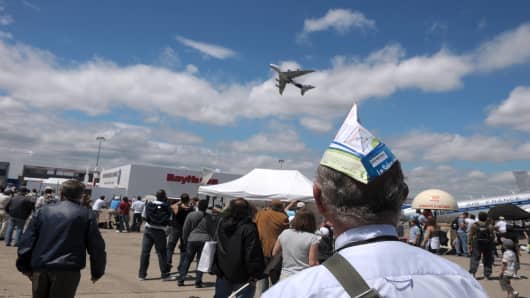The world's oldest and largest aviation show is nearly ready for take-off.
If you're in the aerospace industry, or just an aviation or space junkie, there's no better place to get your fix than at the Paris Air Show.
There will be over 150 aircraft and more than 2,000 exhibits on display– plus each afternoon will feature up to 40 of the latest commercial and defense aircraft in flying demonstrations and exhibitions.
If you're going to the show, be prepared to be overwhelmed – in a good way. That's because the idea of an "air" show has expanded dramatically in the last few years and now encompasses a wide range of aircraft, from small, unmanned robotic drones to the latest super-wide-body jetliners – such as the Boeing 787 Dreamliner and the Airbus A380 – which can be configured to seat up to nearly 470 passengers.
What do these giants look like in-flight? You won't have to wait long to find out. Airbus has just confirmed that British Airways' first A380 will be on display at the show.
(Read More: British Airways to Debut Massive Airbus A380 on London-LA Route)
What else will be making news? Late last week, Eurocopter's X3 broke the helicopter world speed record of 255 knots (472 km/hr), and will wrap-up its final flight-test campaign at the show.
Bombardier is rumored to be ready to announce a new customer for its all-business-class jet that will debut at the show. Controversy surrounds the viability – and profitability – of 100-seat aircraft, but that's not stopping some major players from being ready to make important announcements about such aircraft at the show.
Just a few short years ago, the lion's share of "action" in the aerospace industry was focused on military aircraft. Recently, however, the balance of power has tipped to the commercial side of the industry. One likely by-product of a stronger commercial industry (made stronger, in part, by all the airline bankruptcies and consolidations in recent years): customer service and amenities may soon once again become the competitive battleground in the industry. That will be great news for flyers, but will present new, if "back-to-the-future," challenges for companies.
Still, there are some bright spots in the military sector. Last week, Boeing was awarded a $4 billion contract with the U.S. Army for 177 CH-47F Chinook helicopters. The most groundbreaking news on the military side of the fence, however, may very well be all the interest in UAVs, or Unmanned Air Vehicles (AKA "drones") and other disruptive technologies of today and the future. No longer the stuff of science fiction, UAVs are taking to the airways in a big way – and a big size. Being researched are UAVs as large as fighter jets capable of launching off aircraft carriers, which could perhaps dramatically extend the range of military operations.
(Read More: Dealing in Drones: The Big Business of Unmanned Flight)
There is, however, another aspect to the increasing interest in UAVs,and it's coming from an emerging target market for these vehicles: law enforcement and border patrol agencies. And here's something else to look for: next week will mark the major-air show debut of an autonomous display in which a UAV will fly a pre-programmed route without interference or positive control from a human operator.
What else does the Paris Air Show have to offer? Innovation, and lots of it. From lightweight, composite aviation manufacturing materials to the idea of relieving congestion at busy airports with revolutionary vertical-lift commuting to commercially viable solar-powered aircraft.
Make no mistake: These are exciting, if challenging, times for the aerospace industry. And next week, all the excitement and challenge will be on full display.
David A. Fitzpatrick is managing director at AlixPartners LLP.


